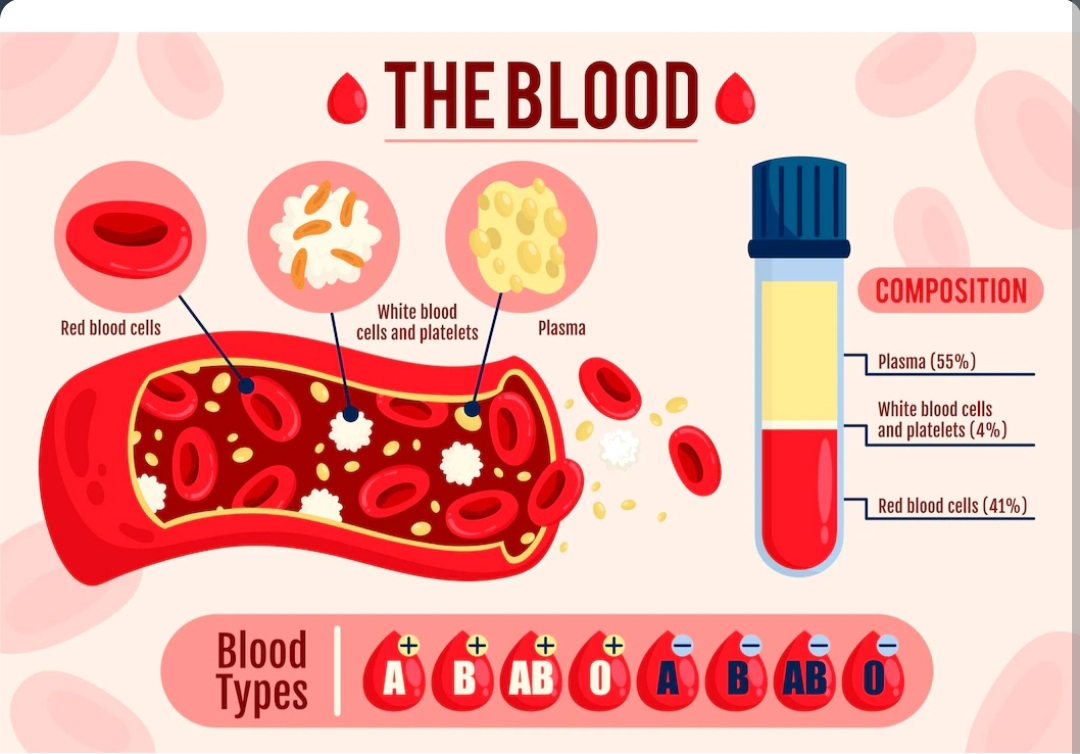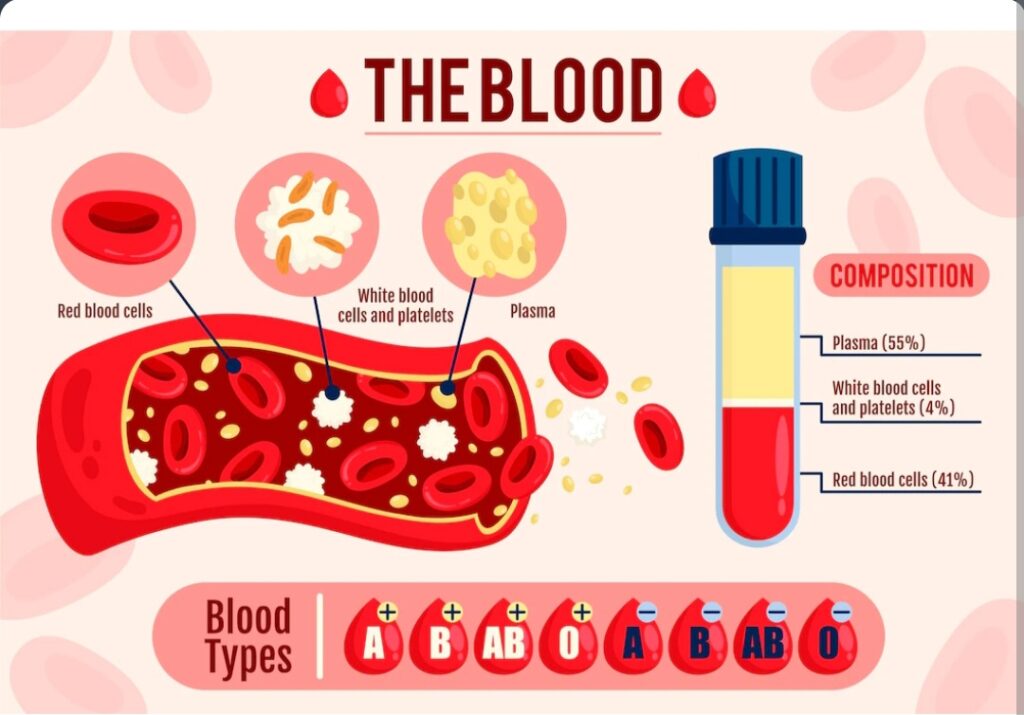Blood is a liquid connective tissue. It is the life stream of the human body as it flows past every cell in the body. Blood constitutes about 8% of body weight. Blood carries oxygen and nutrients to every part of the body. As it travels blood picks up unwanted carbon dioxide and carries it to lungs where it is exhaled.
Blood circulates in the body through a vast network of blood vessels. Different organs work together to keep the blood function smoothly. The heart pumps the blood throughout the body. The lungs supply it with oxygen, and kidneys filter out wastes from the blood. Other organs, such as liver and intestines, supply the blood with food and keep it healthy.
Components of Blood:
The blood has four main parts. It consists of a fluid matrix called plasma and solid constituents such as red blood corpuscles, white blood corpuscles and platelets.
- Plasma: Plasma makes up about 55% of the volume of blood. It contains 90% of water, 8% of proteins and the remaining 2% constituent hormones, food materials such as glucose, amino acids, fatty acids, glycerol, vitamins, salts and urea. Plasma is a yellow fluid which transport materials easily from one part to another part of the body.
The proteins of plasma such as fibrinogen and prothrombin are helpful in clotting of blood. Albumin helps keep the plasma within the blood vessels. If there is decrease in the albumin, plasma fluid escapes out to the tissues. The protein globulin helps to regulate the function of the circulatory system.
- Red Blood Cells: They are spherical and disc shaped with indented centers. They are also called erythrocytes. Red blood cells are made in the bone marrow, one of the tissues inside of bone. A mature RBC loses its nucleus while leaving the bone marrow. They get their red colour from a pigment called haemoglobin, which carries respiratory gases such as carbon dioxide and oxygen. In a healthy individual, there are about 5.4 million RBCs in a cubic mm of blood.
About 1.5 to 2 million RBCs are produced in bone marrow per second. If a person loses a great deal of blood from a serious wound or as a result of blood donation or any other reasons, the bone marrow has to work harder to replace the loss. If the body does not produce enough RBCs, it results in Anaemia.
- White Blood Cells: They help defend the body against external agents. Also called leucocytes, they are of three main types: granulocytes, lymphocytes and, monocytes.
Granulocytes are the amoeboid cells with lobed nucleus. They are produced in the bone marrow. They protect the body against diseases by ingesting the pathogens.
Lymphocytes are produced in lymph glands. They are oval cells with unlobed nucleus. They recognise and destroy antigens, the foreign substances in the body. Lymphocytes are responsible for immunity against diseases, by producing antibodies.
Monocytes are produced in the bone marrow and spleen. They, along with granulocytes, destroy harmful substances.
- Platelets: They are produced by the breakdown of bone marrow cells. They are irregular in shape. They repair small blood vessels and initiate blood clotting.
Blood Clotting:
It is also referred to as coagulation. If the blood does not clot, even a small cut in the skin can be fatal. The person can bleed to death. Clumps of blood consisting of proteins, platelets and blood cells form blood clot prevent excessive bleeding when blood vessels are injured.
Blood Pressure:
The force that blood exerts against the wall of a vessel is called blood pressure. This pressure is much greater in arteries than in veins. The pressure of blood inside the artery during contraction is systolic pressure. The pressure of blood in artery during relaxation is called diastolic pressure. The normal systolic pressure is about 120 mm of Hg and diastolic pressure is 80 mm of Hg.
The instrument used to check blood pressure is sphygmomanometer.
Lack of physical activity, obesity are main reasons for high blood pressure or hypertension. Blood pressure rises with age as arteries lose elasticity.
Low blood pressure or hypotension causes fainting or weakness. Blood pressure sometimes may drop due to loss of blood due to any injury or dehydration.
Blood group:
The blood type of a person can be determined by the presence or absence of substance called agglutinogen in the RBCs.
A and B factors: Blood is grouped based on the two factors of agglutinogens namely A and B.
Rh factors: System of classifying blood groups based on the presence or absence of rh antigen on the cell membrane of RBCs. Rh status of the blood is normally with a positive(+) or negative(-) suffix after the ABO type.
On the basis of factors A, B and Rh, blood is divided into eight groups:
Blood groups with Rh(D) antigen:
- A+, those which contain only A factor
- B+, those which contain only B factor
- AB+, those which contain both A and B factors
- O+, those which contain neither of the two factors.
Blood groups without Rh(D) antigen:
- A-
- B-
- AB-
- O-
Blood groups play an important role in blood transfusion and also organ transplantation. If the blood of two different groups get mixed, they agglutinate or clump together. This may cause severe damage or even death due to block in blood vessels.
Blood group O+ is called universal donor as they do not agglutinate when mixed with any other blood types.
Blood group AB+ is called universal acceptor as it does not cause clot in other blood types. People with AB+ blood type can mostly receive blood from anyone.

